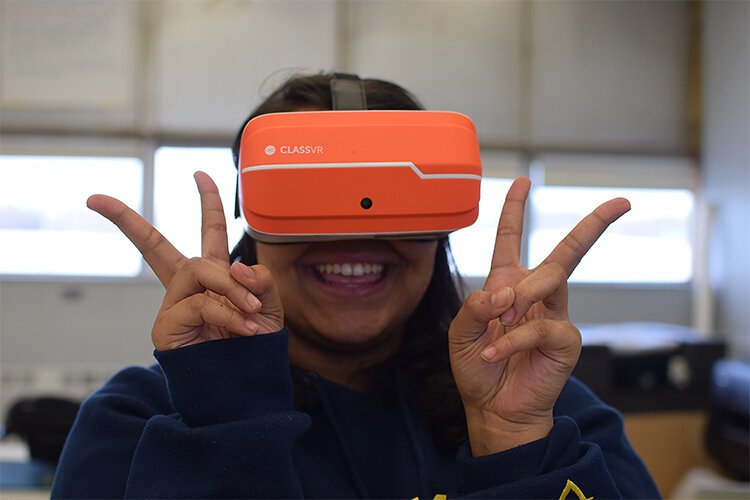Flint Southwestern Classical Academy students pioneer new makerspace
Southwestern Classical Academy students are taking the lead in learning, teaching, and using their newly minted technology. In October of 2019, SCA was awarded a $200,000 investment part of a larger grant of nearly $3 million that has allowed for the purchase of 38 virtual reality headsets, two computerized sewing machines, two 3D printers, and many more devices designed to expand a student’s educational horizons.

FLINT, Michigan—Seniors Aaron Walker and Dianna Johnson of Flint Southwestern Classical Academy huddle over a laptop as they load up a computer-aided design program (CAD). Though school is almost over, the students decide to stay after class and explore SCA’s newly minted makerspace. It’s a first for any Flint community school and administrators are ready to get kids learning, one group of students at a time.
Walker slams the enter key with purpose and the machine in front of him buzzes to life. The two students are only a handful of teens whose applications were accepted to gain authority in using, learning, and teaching the material—all under teacher Suzanne Lossing’s watch of course.
Lossing, art teacher and current Virtual Reality and Makerspace Coordinator at the school, had reached out to other teachers asking for recommendations on who would benefit from the arrival of the new lab made possible by a grant from the Michigan Department of Education.
In October of 2019, SCA was awarded a $200,000 investment part of a larger grant of nearly $3 million that has allowed for the purchase of 38 virtual reality headsets, two computerized sewing machines, two 3D printers, and many more devices designed to expand a student’s educational horizons.
“We’re trying to promote project-based learning and query-based learning … and get kids doing and making,” said Cynthia Bell, an SCA administrator.
She explained that the lab will eventually be integrated into the school’s curriculum and serve over 500 students, but for now, only a select number of students have been selected to break in the equipment.
These recommended students then filled out applications for the program and those who were selected became what Lossing calls “first adopters.”

“They [students] are adopting equipment, they are learning about the equipment, how it operates, writing the standard operating procedures,” said Bell. These first adopters are assigned to specific machines depending on their career interests, which vary from engineering to fashion. Students are then tasked with the responsibility of creating a set of procedures for all future students to follow while operating those machines.
“Once they’re done with that, then they’re creating a project that matches with the career they’re looking forward to or a curriculum they’re currently involved within another class,” said Bell.
The school is committed to taking a tiered approach toward the space, hoping to slowly acclimate separate groups of students to the equipment each semester.
While some students are still getting accustomed to their new equipment and creating a set of standard operating procedures, others are eager to come into the makerspace and put their skills to the test, like Keli Simpson.
She walks into the makerspace minutes after class ends and sits down at one of the room’s two sewing machines as if she’s done it a hundred times before. It’s because she has.
“I mostly make stuffies, like these,” Simpson says as she zips open her backpack and pulls out one of the many colorful stuffed pouches sitting inside of it.
She attributes her interest in sewing to a popular board game. “The [stuffy] actually came from D&D (Dungeons and Dragons). It was this design that I fell in love with,” says Simpson. While creating designs from her favorite game may have been her motivation to start sewing, her skill set has grown since her first encounter with the new machine.
She puts the stuffy down and pulls out a neon green backpack strap as a few students approach her. With finesse, she lines part of the strap up with the sewing machine’s needle and masterfully starts embroidering one of her classmate’s names into it.
Walker, who had started printing a vase just a few moments before, walks over to check on its process. The base has barely been printed. “I sort of do a little bit of everything,” Walker says. “I assist anyone who needs help using the MakerBot (the 3D printer) or VR headsets.”
Walker was assigned to the MakerBot printers because of his love of technology. More than making his own creations, Walker wants to get everyone involved with 3D printing. “I just want to get the printers working so other people in the building can use them.”
While this may be the case, Walker has also made some creations of his own that reflect his love for the world of tech. He walks over to a bin filled with small objects and pulls out a replica of Tesla’s controversial Cybertruck and a cookie cutter in the shape of Tesla’s logo.
Lossing proudly ushers Walker around to show off his creations.
The room is filled with students like Simpson and Walker who have taken on the responsibility of both testing out new equipment and teaching others how to use it. While some machines, like a laser cutter, are yet to be unpacked, all the first adopters have taken to the makerspace and proved that like kids anywhere else, students in Flint have an insatiable need to share, explore, and create.







